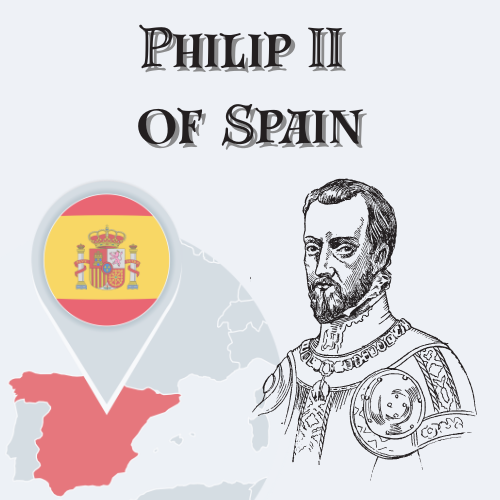
Philip II of Spain
Share
Imagine ruling lands on every continent Europeans knew in the 1500s and believing that God Himself wanted you to keep them Catholic. That was King Philip II of Spain (reigned 1556-1598). Because he claimed his authority came straight from God and concentrated nearly all decision-making in his own hands, historians call him an absolute monarch. Under Philip, Spain became the richest and most wide-spread empire of its day—but it also faced fierce wars and giant money problems.

Philip II of Spain was born on May 21st 1527 in Valladolid, the only legitimate son of Emperor Charles V and Isabella of Portugal. From the time he could read, his father sent him secret letters reminding him that God expected a Habsburg king to defend the Catholic faith and rule with unwavering discipline. Charles proved the lesson by gradually handing his boy real job assignments: first the duchy of Milan in 1540, then Naples and Sicily in 1554, the rich but restless Netherlands in 1555, and, at last, Spain and its vast American colonies in 1556. By his late twenties Philip was master of the wealthiest empire Europeans had ever seen, yet he remained a shy linguist who spoke fluent Castilian but stumbled in French and Dutch—an awkward start for a man about to govern half of Europe.
After touring Italy, Germany, and the Low Countries as a young prince, Philip settled permanently in Spain in 1559. He ruled without leaving the peninsula again, convinced that kingship meant personal, almost solitary labor. Ministers had to submit every request on paper, called consultas, which he read line by line in a small, stuffy office. He penciled answers in the margins and filed the pages in boxes that still survive today. Admirers praised his diligence; critics complained that Spain’s government crawled because “nothing moved without the king’s own hand.”
Religion guided nearly every decision he made. Philip saw himself as God’s “sword” in the Counter-Reformation, backing the Spanish Inquisition at home and fighting Protestantism abroad. His strict policies helped trigger the Dutch Revolt in 1568, beginning the Eighty Years’ War that would eventually split the Netherlands from Spain. To block the Muslim Ottoman navy, he financed the Holy League fleet that won the spectacular Battle of Lepanto in 1571, a clash remembered as the last great victory of oared galleys.
A different kind of crusade took place in the west in 1588. Philip, angered by English raids on his treasure ships and by Queen Elizabeth I’s support for Dutch rebels, launched the 130-ship Spanish Armada to invade England and return it to Catholicism. Storms and English gunpowder scattered his “Invincible” fleet; almost a third of the ships never came home, and Spanish sea power never fully recovered.
Even defeat could not deter the king’s appetite for expansion. When Portugal’s royal line failed in 1580, Philip pressed his own blood claim—his mother had been a Portuguese princess—and sent troops across the border. Within months the Iberian Peninsula was united under one crown, and the king of Spain also called himself Philip I of Portugal. The union added Lisbon’s trade routes in Africa, India, and Brazil to an empire that people said was so wide “the sun never set” on it. The sun shone far beyond Europe. In 1543, years before Philip wore a crown, explorer Ruy López de Villalobos named the islands of Leyte and Samar “Las Islas Filipinas” in the prince’s honor. Later mapmakers applied the name to the whole Philippine archipelago, a lasting reminder of Spain’s global reach.

Rich cargoes of American silver and Asian spices poured into Seville, but imperial wars swallowed money even faster. To keep paying his armies and fleets, Philip borrowed heavily from Genoese and German bankers, then suspended payments in 1557, 1560, 1575, and 1596—the first great state bankruptcies in European history. Each default rattled international credit and forced desperate new taxes at home. Yet the reign was not all paperwork and war. Northwest of Madrid the king built El Escorial, an austere gray complex that served as palace, monastery, library, and royal tomb. Begun in 1563 and finished in 1584, its massive granite blocks and right-angle courtyards reflected Philip’s sober personality and became a model for Spanish “Herrerian” architecture. Inside, he collected manuscripts, maps, and paintings by Titian and Bosch, nurturing a flowering of literature and art that modern scholars call Spain’s Golden Age—an era that also produced Cervantes and the playwright Lope de Vega.
Philip’s final years were spent almost entirely in El Escorial, where chronic gout left him unable to walk. Surrounded by parchments and relics, he continued signing orders until he died on September 13th, 1598. His son, Philip III, inherited not only the grandest empire on earth but also its tangled wars and towering debts. Historians still debate whether the second Philip’s tireless vigilance kept Spain great or whether his insistence on absolute personal control doomed the monarchy to slow-motion decline. Either way, his life offers a vivid lesson: absolute power can build monuments and win legendary battles, but it can also overtax a nation’s people and purse if one man tries to shoulder the whole world alone.
